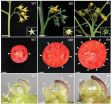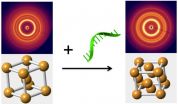Frailer older patients at higher risk of readmission or death after discharge from hospital
2015-05-25
(Press-News.org) Frailer older patients are at higher risk of readmission to hospital or death within 30 days after discharge from a general internal medicine ward, but health care professionals can assess who is at risk using the Clinical Frailty Scale, according to a study in CMAJ (Canadian Medical Association Journal)
Readmission within 30 days after hospital discharge is common and also costly for the health care system. Identifying at-risk patients and addressing the factors contributing to readmission can help reduce recurrences. However, current tools are not able to predict accurately who might be at risk of readmission.
Researchers assessed whether the Clinical Frailty Scale can help predict readmission or death within 30 days after hospital discharge in a group of 495 patients at 2 Alberta hospitals. The Clinical Frailty Scale, an easy-to-use tool developed several years ago, can be used at the bedside by physicians and other health care professionals to determine frailty. The scale measures difficulty in daily living activities with mild frailty (score of 5) corresponding to difficulty with 1 or more complicated daily living activities such as finances, shopping, meal preparation and housework. Moderate frailty (score of 6) indicates difficulty in bathing, dressing or climbing stairs. Severe frailty (score of 7) means a patient is physically or mentally dependent on someone for 3 or more daily living activities.
Of the patients enrolled in the study, half were women, and the median age was 64 years. One-third of the patients (162) were frail, with a score of 5 or higher on the Clinical Frailty Scale in the week before admission to hospital. Within 30 days after discharge, 85 patients (17%) were readmitted or had died. Compared with nonfrail patients, frail patients were at greater risk of readmission or death within 30 days (24% v. 14%), especially those with moderate or severe frailty (31% v. 14%). Inclusion of frailty assessments improved the prediction of post-discharge outcomes, leading the authors to suggest that this assessment be included in discharge planning procedures to help identify patients at highest risk of poor transition from hospital to home.
The researchers suggest that a variety of factors may contribute to readmission to hospital.
"Although frailty or vulnerability before becoming ill may affect outcomes after discharge, patients in hospital may also experience an acquired, transient period of risk for adverse events that is harmful in addition to the stress of the acute illness," writes Dr. Finlay McAlister, University of Alberta, with coauthors. "This 'post-hospital syndrome' is a multidimensional construct that incorporates sleep deprivation, cognitive stress, poor nutrition and physical pain. Patients who are already frail before hospital admission may be more sensitive to the stresses of this syndrome and at higher risk of readmission and poor outcomes."
The Clinical Frailty Scale can be a useful tool for health care professionals to identify patients at high risk of readmission and provide support to lessen the likelihood of readmission.
INFORMATION:
ELSE PRESS RELEASES FROM THIS DATE:
2015-05-25
This news release is available in French. Scientists measuring brain activity have found that in many regions, such as the sensory or motor cortex, activity sometimes oscillates at different frequencies, forming wave-like patterns. Despite the fact that such oscillations are frequently observed, and present in many brain regions, their functional role remains unclear. Research done by Dr. Christopher Pack, from McGill University, who looked at such waves occurring in a region of the visual cortex of the brain, suggests these oscillations could have a role in resetting ...
2015-05-25
Cold Spring Harbor, NY -- A team of scientists at Cold Spring Harbor Laboratory (CSHL) has identified a set of genes that control stem cell production in tomato. Mutations in these genes explain the origin of mammoth beefsteak tomatoes. More important, the research suggests how breeders can fine-tune fruit size in potentially any fruit-bearing crop. The research appears online today in Nature Genetics.
In its original, wild form the tomato plant produces tiny, berry-sized fruits. Yet among the first tomatoes brought to Europe from Mexico by conquistador Hernan Cortez in ...
2015-05-25
UPTON, NY -- Scientists at the U.S. Department of Energy's Brookhaven National Laboratory have just taken a big step toward the goal of engineering dynamic nanomaterials whose structure and associated properties can be switched on demand. In a paper appearing in Nature Materials, they describe a way to selectively rearrange the nanoparticles in three-dimensional arrays to produce different configurations, or phases, from the same nano-components.
"One of the goals in nanoparticle self-assembly has been to create structures by design," said Oleg Gang, who led the work ...
2015-05-25
New research conducted in a rural community in Pakistan highlights the crucial role that essential fatty acids play in human brain growth and function.
A team co-led by the University of Exeter, working with experts in Singapore, has published findings in Nature Genetics which show that mutations in the protein Mfsd2a cause impaired brain development in humans. Mfsd2a is the transporter in the brain for a special type of fat called lysophosphatidylcholines (LPCs) -- which are composed of essential fatty acids like omega-3. This shows the crucial role of these fats in ...
2015-05-25
Having a healthy gut may well depend on maintaining a complex signaling dance between immune cells and the stem cells that line the intestine. Scientists at the Buck Institute are now reporting significant new insight into how these complex interactions control intestinal regeneration after a bacterial infection. It's a dance that ensures repair after a challenge, but that also goes awry in aging fruit flies -- the work thus offers important new clues into the potential causes of age-related human maladies, such as irritable bowel syndrome, leaky gut and colorectal cancer.
"We've ...
2015-05-25
May 26, 2015, Shenzhen, China - Researchers from BGI reported the most complete haploid-resolved diploid genome (HDG) sequence based on de novo assembly with NGS technology and the pipeline developed lays the foundation for de novo assembly of genomes with high levels of heterozygosity. The latest study was published online today in Nature Biotechnology.
The human genome is diploid, and knowledge of the variants on each chromosome is important for the interpretation of genomic information. In this study, researchers presented the assembly of a haplotype-resolved diploid ...
2015-05-25
A gene essential to the production of pain-sensing neurons in humans has been identified by an international team of researchers co-led by the University of Cambridge. The discovery, reported today in the journal Nature Genetics, could have implications for the development of new methods of pain relief.
Pain perception is an evolutionarily-conserved warning mechanism that alerts us to dangers in the environment and to potential tissue damage. However, rare individuals - around one in a million people in the UK - are born unable to feel pain. These people accumulate numerous ...
2015-05-25
Scientists at the University of York's Centre for Quantum Technology have made an important step in establishing scalable and secure high rate quantum networks.
Working with colleagues at the Technical University of Denmark (DTU), Massachusetts Institute of Technology (MIT), and the University of Toronto, they have developed a protocol to achieve key-rates at metropolitan distances at three orders-of-magnitude higher than previously.
Standard protocols of Quantum Key Distribution (QKD) exploit random sequences of quantum bits (qubits) to distribute secret keys in a completely ...
2015-05-25
TORONTO, May 25, 2015 - A new, Ontario-wide study shows that rates of hospital readmission following a traumatic brain injury (TBI) are greater than other chronic diseases and injuries and are higher than previously reported.
The study, led by Dr. Angela Colantonio, senior scientist, Toronto Rehabilitation Institute, UHN, examined nearly 30,000 TBI patients discharged from Ontario hospitals over the span of eight years. Published in the May edition of Archives of Physical Medicine and Rehabilitation, the study found that about 36 per cent of patients with TBI had been ...
2015-05-25
Madagascar is home to extraordinary biodiversity, but in the past few decades, the island's forests and associated biodiversity have been under greater attack than ever. Rapid deforestation is affecting the biotopes of hundreds of species, including the panther chameleon, a species with spectacular intra-specific colour variation. A new study by Michel Milinkovitch, professor of genetics, evolution, and biophysics at the University of Geneva (UNIGE), led in close collaboration with colleagues in Madagascar, reveals that this charismatic reptilian species, which is only ...
LAST 30 PRESS RELEASES:
[Press-News.org] Frailer older patients at higher risk of readmission or death after discharge from hospital


